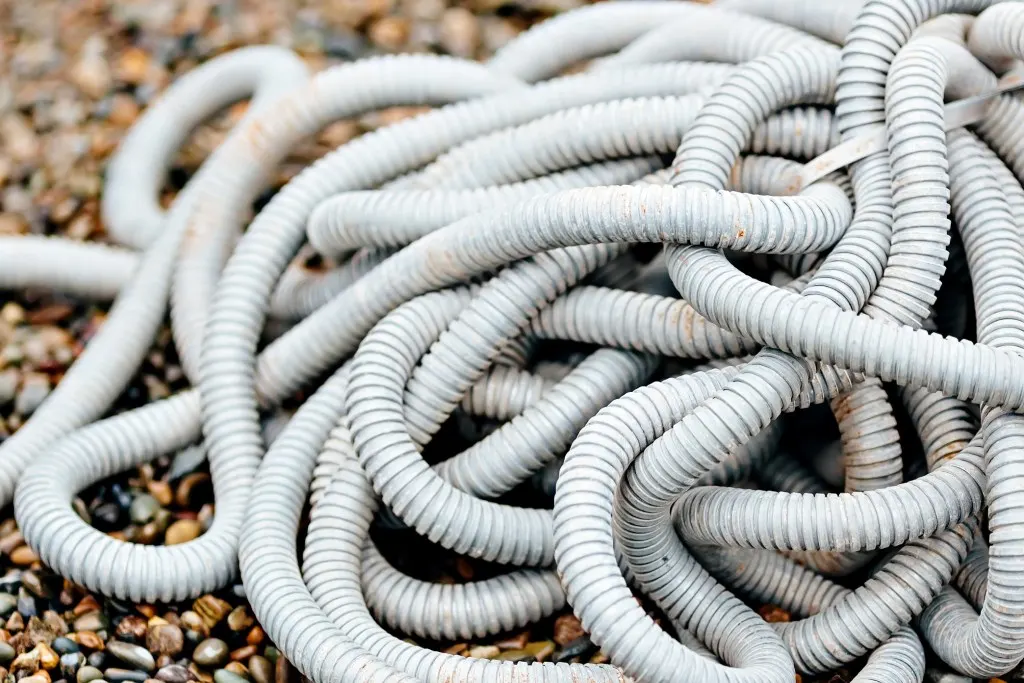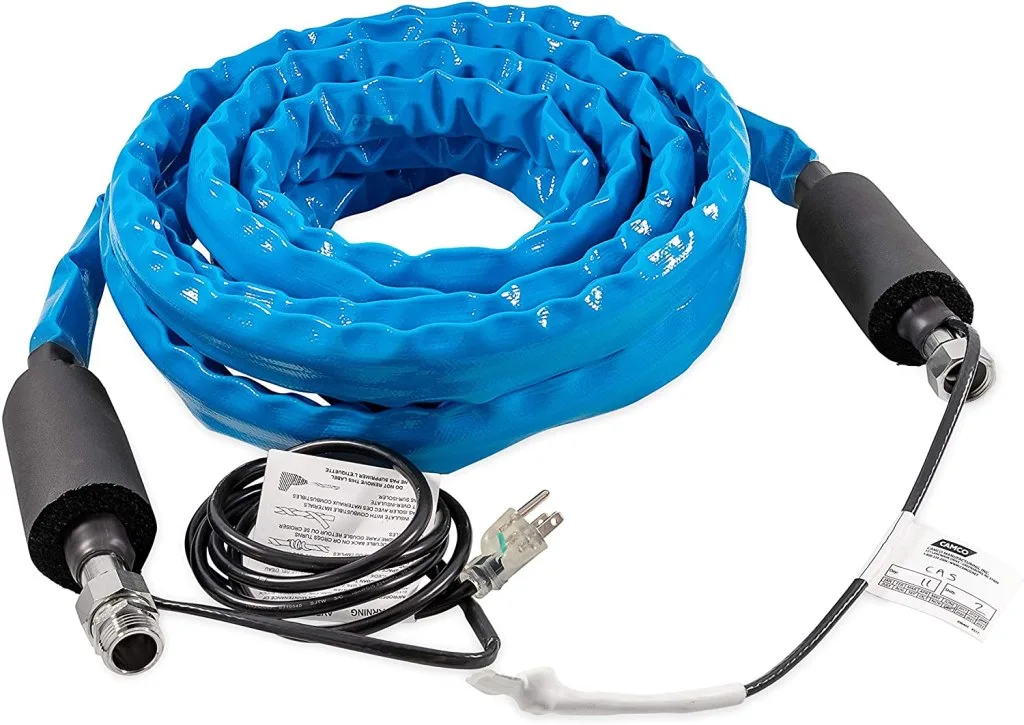You’re camping in the Great Smoky Mountains in early November, enjoying the beauty of the fall colors when you get a freeze alert on your weather app.
If you didn’t prepare for freezing temperatures, you’ll find yourself scrambling in a situation like this. And it’s a lot more common than you might think.
One simple solution is to buy a heated RV water hose.
Let’s look at why this is a good idea for camping!
Why Would You Need a Heated RV Water Hose for Your RV?
When temperatures drop below freezing, the chance that the water in your tanks and pipes will freeze increases.
Even with temperatures hovering around the freezing mark, if the cold lasts a few hours, you could deal with bursting pipes.
A heated RV water hose warms itself, so the water coming out of the spigot and into your RV is also warm. This reduces the chance of freezing.
How Does a Heated RV Water Hose Work?
A heated RV water hose is well-insulated (and usually blue) and comes with electrical elements that heat the hose. You plug the heat strip along the side of the hose into an outlet.
When not plugged in, it operates as a regular hose. When plugged in, it heats the hose. Sometimes these hoses are called “no-freeze water hoses.”
Are There Any Disadvantages to Using a Heated Water Hose?
Not really. It’s essential if you’re traveling to areas that will see sub-freezing temperatures. The only disadvantage is the cost. These are more expensive than regular RV water hoses.
But again, they’re a must-have for RV living during cold winters. So you can’t really get around that.
Pro Tip: If you’re new to winter RVing, you may be wondering Can RV Pipes Freeze in One Night? Let’s find out!

How to Choose a Good Heated Water Hose
There are a few things to note when choosing a heated water hose. It’s important to know what you’re looking for so you choose the best option for your needs.
Just because your neighbor has a 20-ft Camco heated RV water hose doesn’t mean that’s the right one for you. Let’s take a closer look!
Check the Length
First, you have to choose the length that works for your rig. Where is your water connection? How far is it from where the water spigot will be at RV parks?
Campgrounds vary in where they put the pedestal and spigot. You need your heated water hose to be able to reach those items regardless. Typical hoses come in lengths of 25 or 50 feet.
Is It Drinking-Water Safe?
You must make sure that your heated water hose is rated for safe drinking water. Don’t use a garden hose. Not all heated water hoses are RV-safe, so you want to make sure you read the fine print. This water is coming into your RV for drinking and washing, after all.
What Is the Energy Draw?
Because it’s a heated RV water hose and needs electricity, you’ll want to check the energy draw. For example, the No Freeze 25-ft heated water hose pulls 2,500 watts. The Pirit 25-ft heated water hose pulls 1.5 amps. The Camco 25-ft heated water hose has a self-regulating thermostat, so it only turns on when needed, thus saving energy.
Know how much energy you’re using, especially if you often boondock in colder temperatures.

Is It Self-Regulating?
As mentioned above, one feature of the Camco heated RV water hose is the self-regulating thermostat. It won’t heat the hose if the temperature outside is 37 degrees.
Other companies’ products also have this feature, so make sure the heated RV water hose you choose is indeed self-regulating.
You won’t be pulling electricity when you don’t need it.
What Is the Temperature Rating?
Make sure to check out the freeze protection. Most heated RV water hoses will work until the temperature dips below -20 degrees Fahrenheit.
If you’re staying in Alaska or Montana, you’ll want to find a hose rated to work until the temperature dips below -50 degrees Fahrenheit.
What Is the Price?
These heated RV water hoses are more expensive than regular RV water hoses. If you aren’t going to be staying in locations with near-freezing temperatures, you don’t need to spend the money to buy one.
But if you do travel or live in areas with colder temperatures, you’ll want to fork over the $100-$200 to have one in your RV.
Depending on the length you need, you’ll spend a little less or a little more.

Source: amazon.com/camco
Pro Tip: If your RV hose cracked and you’re looking for a new one, check out these RV Sewer Hose: Decent, Better, and Best.
Do You Have to Have a Heated Water Hose When Winter Camping?
You don’t have to have a heated RV water hose if you aren’t staying in areas with sub-freezing temperatures. And there are other things you can do if you choose not to buy a heated RV water hose, like wrapping or taping your current hose.
But it’s one of the easiest ways to protect your hose from cracking and leaking during the winter.
Is Buying a Heated RV Water Hose Worth the Cost?
It’s worth the cost just for some added peace of mind. You don’t have to worry about your hose cracking in the middle of the night and not having access to water in the morning. If you’re only going to be camping in colder temperatures a couple of nights a year, then it’s not worth it.
But if you regularly travel or live in colder areas, you’ll want to purchase a heated RV water hose.
A heated RV water hose is a great addition to your RV arsenal. You won’t use it all the time, but when you need it, it’s there.
Even with the more expensive price tag, it’s well worth taking along with you. Buying two or three water hoses after the first one splits open due to freezing temperatures will add up.
Go ahead and purchase a heated RV water hose if you’ll be doing any traveling in colder temperatures.
Where will you be camping this winter? Drop a comment below!
Discover the Best Free Camping Across the USA
To be honest with you, we hate paying for camping. There are so many free campsites in America (with complete privacy).
You should give it a try!
As a matter of fact, these free campsites are yours. Every time you pay federal taxes, you’re contributing to these lands.
Become a FREE CAMPING INSIDER and join the 100,000 campers that love to score the best site!
We’ll send you the 50 Best Free Campsites in the USA (one per state). Access the list by submitting your email below:
the no-freeze 25 ft water hose. is that possible to draw 2500 watts? that would be around 20 amps at 120 volts wouldn’t it/